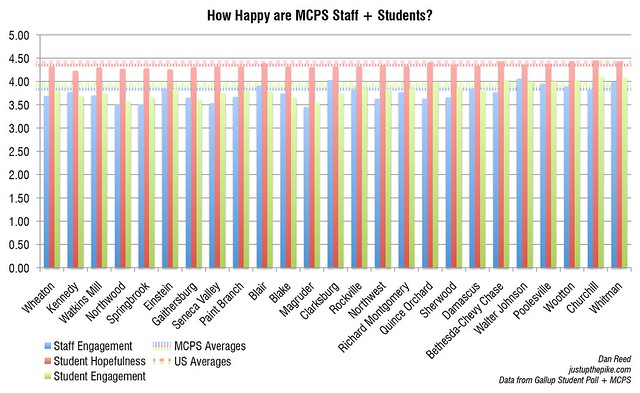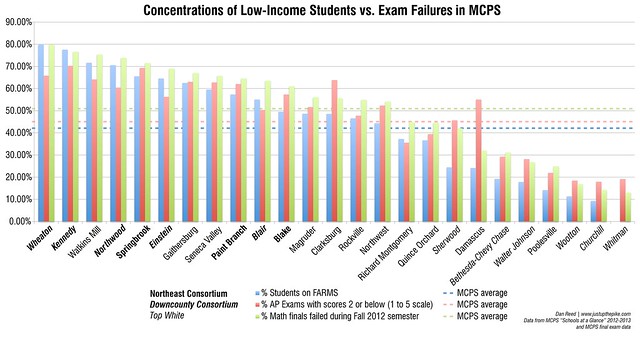Citing studies that show a connection between happiness and student performance, Montgomery County Public Schools are surveying students and staff on how hopeful and engaged they are. But it may not be a good measure of a school's quality.
MCPS hired national polling firm Gallup to administer the surveys, which cost $900,000 for 3 years of work and can be found online. Superintendent Dr. Joshua Starr feels the school system shouldn't only measure success by test scores, but by the social and emotional health of its students and employees.
The surveys ask students and teachers to respond to statements like "I have a best friend at school", "I can energetically pursue my goals", and "Did you smile or laugh a lot yesterday?" Respondents rank their feelings on a scale of 1 to 5, which are then compiled for the entire school and compared to averages for MCPS and for the United States as a whole.
Gallup's found some pretty interesting insights, like that students become less engaged in school as they get older. But it's unclear how meaningful hopefulness is as a measure of student performance.
One study cited in the Washington Post says that emotions have an affect on student performance, but a review of recent studies conducted by NIH researchers suggests a more tenuous connection. We know that students who are bullied and harassed at school often do worse, so presumably students in positive, supportive school environments are doing better.
So are students at the county's highest-ranked schools outperforming their counterparts elsewhere because they're happier at school? Not really. If you look at this year's surveys for the county's 26 high schools, the correlation between student happiness and academic performance looks pretty weak.
Students in MCPS are generally happy. Systemwide, they rated their "hopefulness" at 4.35 out of 5 and their feelings of engagement at 3.84 out of 5. But these scores don't change very much from school to school. The system's least-hopeful school, Kennedy High in Silver Spring, scored just 4.23 out of 5, compared to 4.45 out of 5 at Churchill High in Potomac, the most-hopeful campus.
Not only that, but students in MCPS aren't any more hopeful or engaged than students in the US as a whole. In other words, students everywhere like their school. MCPS officials seem to understand this. When I interviewed Dr. Starr last month, he emphasized that most students and families were satisfied with their schools.
But this says less about a school or MCPS than it does about kids and parents, who often don't have any context of how their school compares to other schools. And in a place like Montgomery County, which has long held a reputation for great schools, people might assume that their school is the best, whether it's one that privately raised over $1 million for a new soccer field or didn't have a drama program for several years.
As a result, if a student, parent or faculty member has a bad experience, they might just assume it's simply their problem, not an indication that something's wrong with their school or MCPS.
I loved my high school, and I generally felt hopeful about my future. But hope wasn't enough to help me take rigorous AP classes, to graduate on time, or to get me into college. It's because I went to school with teachers who were not only talented but supportive, with administrators who set high standards for the whole school community, and a diverse student body that reflected the world I'd go into as an adult.
Students should like where they go to school, but unfortunately, students will like their school regardless of how good it is. And in MCPS, which is struggling to deal with huge demographic changes, increasing school segregation, and declining academic performance in some schools, measuring students' hopefulness is at best a distraction.
 |
| This year's Gallup Student Polls for Montgomery County. All images by the author unless noted. |
MCPS hired national polling firm Gallup to administer the surveys, which cost $900,000 for 3 years of work and can be found online. Superintendent Dr. Joshua Starr feels the school system shouldn't only measure success by test scores, but by the social and emotional health of its students and employees.
The surveys ask students and teachers to respond to statements like "I have a best friend at school", "I can energetically pursue my goals", and "Did you smile or laugh a lot yesterday?" Respondents rank their feelings on a scale of 1 to 5, which are then compiled for the entire school and compared to averages for MCPS and for the United States as a whole.
Gallup's found some pretty interesting insights, like that students become less engaged in school as they get older. But it's unclear how meaningful hopefulness is as a measure of student performance.
One study cited in the Washington Post says that emotions have an affect on student performance, but a review of recent studies conducted by NIH researchers suggests a more tenuous connection. We know that students who are bullied and harassed at school often do worse, so presumably students in positive, supportive school environments are doing better.
So are students at the county's highest-ranked schools outperforming their counterparts elsewhere because they're happier at school? Not really. If you look at this year's surveys for the county's 26 high schools, the correlation between student happiness and academic performance looks pretty weak.
 |
| How each of the county's 26 high schools ranks for employee happiness, student hopefulness and student engagement. |
Students in MCPS are generally happy. Systemwide, they rated their "hopefulness" at 4.35 out of 5 and their feelings of engagement at 3.84 out of 5. But these scores don't change very much from school to school. The system's least-hopeful school, Kennedy High in Silver Spring, scored just 4.23 out of 5, compared to 4.45 out of 5 at Churchill High in Potomac, the most-hopeful campus.
Not only that, but students in MCPS aren't any more hopeful or engaged than students in the US as a whole. In other words, students everywhere like their school. MCPS officials seem to understand this. When I interviewed Dr. Starr last month, he emphasized that most students and families were satisfied with their schools.
 |
| Exam failures at each of the county's 26 high schools. (The schools are in the same order for easy comparison.) |
But this says less about a school or MCPS than it does about kids and parents, who often don't have any context of how their school compares to other schools. And in a place like Montgomery County, which has long held a reputation for great schools, people might assume that their school is the best, whether it's one that privately raised over $1 million for a new soccer field or didn't have a drama program for several years.
As a result, if a student, parent or faculty member has a bad experience, they might just assume it's simply their problem, not an indication that something's wrong with their school or MCPS.
I loved my high school, and I generally felt hopeful about my future. But hope wasn't enough to help me take rigorous AP classes, to graduate on time, or to get me into college. It's because I went to school with teachers who were not only talented but supportive, with administrators who set high standards for the whole school community, and a diverse student body that reflected the world I'd go into as an adult.
Students should like where they go to school, but unfortunately, students will like their school regardless of how good it is. And in MCPS, which is struggling to deal with huge demographic changes, increasing school segregation, and declining academic performance in some schools, measuring students' hopefulness is at best a distraction.

1 comment:
Holy crap. I don't know whether to laugh or cry that MCPS spent a mill to find out that, in summary, the white kids are more hopeful, and that senioritis exists. While I'm personally sort of used to a business context where a million bucks isn't quite real money (I work with, but not for, the Federal government), MCPS isn't that context--a million bucks is a nontrivial raise for every teacher at six or seven high schools.
Good archaeology, Dan.
Post a Comment